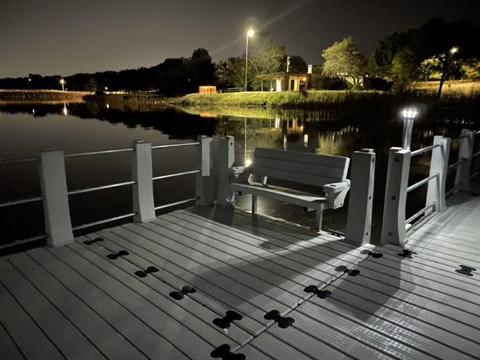Lake Como Park

Dedication
Size
Additional amenities
- Basketball Court
- Benches
- Drinking Fountain
- Grills
- Observation Deck
- Park Lighting
- Parking Lot
- Playground Area
- Shelters
- Tables
- Tennis Courts
- Tables
- Water Feature
Fun Facts & History
The origins of Lake Como date to the last decade of the nineteenth century. In 1890, Denver investors Alfred W. and H. B. Chamberlin, along with area investors, had two thousand acres of prairie land west of the Clear Fork of the Trinity River platted as “Chamberlin Arlington Heights.” The investors envisioned a grand development and enlisted the aid of prominent Fort Worth architect Marshall Sanquinet to design stately homes for the community. Approximately twenty of these homes and a resort hotel, Ye Arlington Inn, were completed by 1892. Other improvements included the creation of Lake Como in the southwest corner of the subdivision. The lake took its name from the famous Italian resort. A fine pavilion and boathouse were also constructed as was a powerhouse used to generate electricity for the operation of a streetcar line to the lake. This was a common practice of early developers as a way of generating traffic not only to a recreational destination but also to provide access to the rest of the development. However, the financial crisis of 1893 suppressed further development of the Arlington Heights area and it was not until World War I and the establishment of Camp Bowie that Arlington Heights rebounded and was annexed into the city in 1922.
An African American community began to develop around the lake in the early decades of the twentieth century. It was common for residents to use the lake and its surroundings for recreational purposes. For example, while Fort Worth’s white community was gearing up for a big celebration of Texas’ independence from Mexico in 1936 with the construction of Casa Manaña, a frontier village, the Will Rogers Complex, and other facilities associated with the Fort Worth Frontier Centennial, “A Century of Negro Progress,” a centennial exposition specifically for the city’s black community, was held at Lake Como. The four-day event, which was also tied to the community’s traditional “Juneteenth” celebration, included a midway, an exhibition building, and a night club.
By 1950, there was still not a public park to serve the black community on the city’s west side. In October 1952, Amon G. Carter gave to the city 86.5 acres at Lake Como for use as a park for this purpose. The gift followed a request from the park board in 1951 to Mr. Carter asking that he give the area around Lake Como for this purpose. In 1955, the park department received $25,000 from the Amon G. Carter Foundation for the development and improvement of the park. This gift came from the sale of residential lots on the east and north edges of the lake which Carter had directed to be sold for this purpose. When this money became available, park director Hamilton Hittson thought the funds should go toward the construction of a shelter in the park, which was built by Horace O. Duncan. Following its completion, a dedication ceremony was held in June 1956. A swimming pool and bathhouse were built the following year. The engineer for the project was Robin Llewellyn. The landscape architect was the firm of Carter and Burgess.
Lake Como Park received playground improvements in 1998. The historic shelter still exists. There are also tennis courts, grills, and fishing is allowed in the lake.
View animal, plant and insect species observed at Lake Como Park and make some of your own observations through iNaturalist. See link under the "Related information" Section
Reserve this park on ActiveNet
Location
3401 Lake Como Drive, Fort Worth 76107 View Map
32.7249263,-97.3969089
3401 Lake Como Drive ,
Fort Worth 76107
3401 Lake Como Drive ,
Fort Worth 76107
Lake Como Park